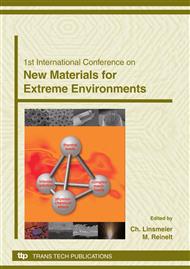p.96
p.101
p.105
p.111
p.116
p.120
p.125
p.131
p.138
Comparative Study of Predictive Finite Element Methods for Mechanical Properties in 2D Woven Carbon/Carbon Composites
Abstract:
Three-dimensional finite element (FE) methods are used to predict the Young’s modulus of two types of 2D woven carbon/carbon composites. Tensile tests are performed to validate the predictions. The results indicate that a novel image-based route in generating FE meshes gave strong agreement with experimental data, while a comparative unit cell FE model of the structure was found to be poorer. The differences between the image-based and unit cell methodologies were the consideration of the finer architectures of the composites and their porosity. The image-based approach highlighted true porosity in the structure due to meshes forming directly from X-ray tomographic data. However, the finer fibre architectures of the composites were compromised because of limitations in the pixel resolutions employed during the initial scanning process. In comparison, the unit cell models were based solely on idealisations of the composite microstructure, in which porosity was neglected.
Info:
Periodical:
Pages:
116-119
Citation:
Online since:
December 2008
Price:
Сopyright:
© 2009 Trans Tech Publications Ltd. All Rights Reserved
Share:
Citation:


